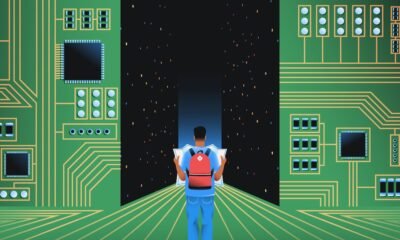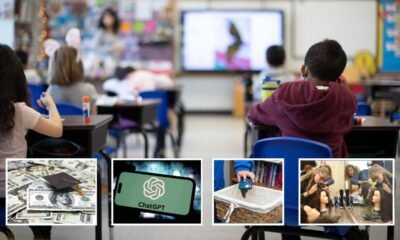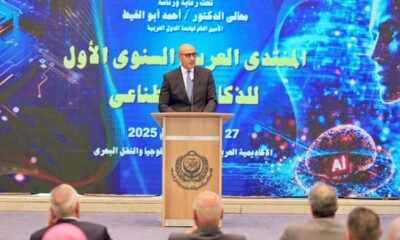Education
Traditional vs. Modern AI-Based Education: Balancing Human Effort and Technological Guidance

Introduction
Education has always been the foundation of personal growth, societal development, and economic progress. Over the centuries, the methods of education have evolved—shifting from oral traditions to printed books, from chalkboards to interactive screens, and now, from teacher-led classrooms to artificial intelligence (AI)-driven learning platforms.
While AI has opened doors to personalized education, accessibility, and efficiency, the transition from traditional to modern education has raised important questions: Can machines replace the dedication of parents and teachers? Will AI-based systems guide children toward success, or could they lead them astray without proper guidance? To answer these questions, we must explore the characteristics of both traditional and modern AI-based education, the role of parents and teachers in this shift, and the ethical responsibilities that come with it.
1. Traditional Education: The Pillars of Hard Work and Personal Guidance
Traditional education has always been rooted in the human connection between teachers, students, and parents. Its strength lies in:
Personal Attention and Mentorship:
Teachers not only convey academic knowledge but also mentor students in life skills, discipline, and ethics. Parents complement this by monitoring homework, attending school meetings, and instilling values at home.
Human Understanding of Learning Pace:
Teachers understand when a student is struggling—not just from test scores but from subtle behavioral cues. This emotional intelligence ensures that no child is left behind.
Emphasis on Hard Work:
In the traditional system, students are encouraged to push through challenges, develop perseverance, and value the process of learning, rather than relying on shortcuts.
Community-Based Learning:
Schools create social environments where students learn teamwork, leadership, and respect through face-to-face interactions.
Moral and Cultural Education:
Alongside academic learning, traditional systems often integrate moral lessons, civic responsibilities, and cultural heritage—ensuring holistic development.
However, traditional methods also have limitations—such as rigid curriculums, slower adaptability to individual needs, and limited access to quality education in rural or underdeveloped areas.
2. Modern AI-Based Education: Automation and Personalization
In the modern era, AI has entered classrooms and homes, transforming how students learn. AI-powered platforms offer:
Personalized Learning Paths:
AI systems adapt content according to a student’s performance, offering customized challenges or additional practice as needed.
24/7 Availability:
Students can access learning materials anytime, removing geographical and time barriers.
Instant Feedback and Progress Tracking:
AI systems can evaluate a student’s work instantly, allowing them to learn from mistakes without long delays.
Multimedia-Based Learning:
Lessons can be delivered using interactive videos, games, simulations, and virtual reality—making complex topics easier to understand.
Reduced Workload for Teachers:
AI tools automate grading, attendance, and administrative tasks, allowing educators to focus more on personalized guidance for each student.
Despite these benefits, AI-based education has risks:
Reduced Human Interaction: Overreliance on machines may limit a child’s emotional and social development.
Ethical Risks: Without parental and teacher guidance, children might misuse technology or fall prey to misinformation.
Lack of Emotional Understanding: AI cannot yet fully understand human emotions, body language, or the deeper context behind a student’s struggles.
3. The Parent and Teacher’s Role in the AI Era
Even in a modern AI-based education system, the role of parents and teachers is irreplaceable. The focus has shifted from being the sole source of knowledge to being mentors, guides, and ethical anchors.
a) Teaching How to Use AI Effectively
Parents and teachers must help children understand that AI is a tool—not a replacement for human thinking. They should guide students in how to verify information, cross-check sources, and use AI for constructive purposes rather than entertainment alone.
b) Ethics and Digital Citizenship
In a connected world, children face risks such as cyberbullying, privacy invasion, and exposure to harmful content. Parents must teach children about online safety, data privacy, and respectful digital communication.
c) Preserving Human Values
Hard work, patience, empathy, and teamwork should not be lost in the AI era. These qualities need active reinforcement at home and in school.
d) Emotional Support
AI can simulate tutoring but cannot replace the encouragement of a parent or the inspiration of a passionate teacher. Emotional motivation is crucial to a child’s success.
4. Balancing Tradition and Modernity
The future of education lies in blending the strengths of both systems. Here’s how:
Hybrid Learning Models:
Combine AI-based lessons with teacher-led discussions to ensure both personalization and human mentorship.
Parent Training Programs:
Schools should organize sessions for parents to learn how to use AI-based apps so they can monitor and guide their child’s progress effectively.
Ethics Curriculum:
Integrating digital ethics and social responsibility into the school syllabus will prepare students to be responsible tech users.
Community Learning with AI Support:
Even in AI-driven learning, group projects, debates, and sports should remain to build social and leadership skills.
5. Risks of Ignoring Ethical Guidance in AI Education
If parents and teachers do not take an active role, several negative outcomes may occur:
Overreliance on AI: Students may depend too much on AI-generated answers, losing critical thinking skills.
Loss of Discipline: Without human supervision, students might avoid challenging tasks and rely on shortcuts.
Isolation: Lack of peer interaction can lead to weaker communication and teamwork abilities.
Exposure to Harmful Content: AI systems, if not properly monitored, might recommend inappropriate or misleading materials.
Conclusion
Traditional education built a strong foundation of discipline, values, and perseverance through the hard work of parents and teachers. Modern AI-based education brings efficiency, personalization, and global accessibility. But while technology can make learning faster and more engaging, it cannot replace the human touch that shapes character, instills ethics, and inspires greatness.
The real challenge is not choosing between traditional and modern education but learning how to merge them effectively. Parents and teachers must evolve into digital mentors—helping children navigate AI-based learning while reinforcing the timeless values that define true success.
If we achieve this balance, AI will not replace human educators—it will empower them, creating a future where children are both technologically skilled and ethically grounded.
Education
College president fears that federal education cuts will derail the promise of student parents, student military veterans and first-gen students

As a college president, I see the promise of higher education fulfilled every day. Many students at my institution, Whittier College, are the first in their families to attend a university. Some are parents or military veterans who have already served in the workforce and are returning to school to gain new skills, widen their perspectives and improve their job prospects.
These students are the future of our communities. We will rely on them to fill critical roles in health care, education, science, entrepreneurship and public service. They are also the students who stand to lose the most under the proposed fiscal year 2026 federal budget, and those who were already bracing for impact from the “One Big Beautiful Bill” cuts, including to the health care coverage many of them count on.
The drive with which these extraordinary students — both traditionally college-aged and older — pursue their degrees, often while juggling caregiving commitments or other responsibilities, never fails to inspire me.
Related: Interested in innovations in higher education? Subscribe to our free biweekly higher education newsletter.
We do not yet know the precise contours of the spending provisions Congress will consider once funding from a continuing resolution expires at the end of September. Yet we expect they will take their cues from the president’s proposed budget, which slashes support for students and parents and especially hammers those already struggling to improve their lives by earning a college degree, with cuts to education, health and housing that could take effect as early as October 1.
That budget would mean lowering the maximum Pell Grant award from $7,395 to $5,710, reversing a decade of progress. For the nearly half of Whittier students who received Pell Grants last year, this rollback would profoundly jeopardize their chances of finishing school.
So would the proposal to severely restrict Federal Work-Study, which supports a third of Whittier students according to our most recent internal analysis, and to eliminate the Supplemental Educational Opportunity Grant, which more than 16 percent of our student body relies upon. In addition, this budget would impose a cap on Direct PLUS Loans for Parents, which would impact roughly 60 percent of our parent borrowers. It would also do away with the Direct PLUS Loans for Graduates program.
These programs are lifelines, not just for our students but for students all across the country. They fuel social mobility and prosperity by making education a force for advancement through personal work ethic rather than a way to rack up debt.
If enacted, these proposed cuts would gut the support system that has enabled millions of low-income students to earn a college degree.
Higher education is a bridge. To cross it and achieve their full potential, students from all walks of life must have access to the support and resources colleges provide, whether through partnerships with local high schools or with professional gateway programs in engineering, accounting, business, nursing, physical therapy and more. Yet, to access these invaluable programs, they must be enrolled. How will they reach such heights if they suddenly can’t afford to advance their studies?
The harm I’ve described doesn’t stop with cuts to financial aid, loans and services. Proposed reductions also target research funding for NASA, NIH and the National Science Foundation. One frozen NASA grant has already led to the loss of paid student research fellowships at Whittier, a setback not just in dollars but in momentum for students building real-world skills, networks and résumés.
These research opportunities often enable talented first-generation students to connect their classroom learning to career pathways, opening the door to graduate school, lab technician roles and futures in STEM fields. We’ve seen how federal funding has supported student projects in everything from climate data analysis to environmental health.
Stripping away support for hands-on research undermines the federal government’s own calls for colleges like ours to better prepare students for the workforce by dismantling the very mechanisms that make such preparation possible.
It’s particularly disheartening that these changes will disproportionately hurt those students who are working the hardest to achieve their objectives, who have done everything right and have the most to lose from this lack of investment in the future.
The preservation and strengthening of Pell, Work-Study, Supplemental Educational Opportunity grants and federal loan programs is not a partisan issue. It is a moral and economic imperative for a nation that has long been proud to be a land of opportunity.
Let’s build a system for strivers that opens doors instead of slamming them shut.
Let’s recommit to higher education as a public good. Today’s students are willing to work hard to deserve our continuing belief in them.
Kristine E. Dillon is the president of Whittier College in California.
Contact the opinion editor at opinion@hechingerreport.org.
This story about education cuts was produced by The Hechinger Report, a nonprofit, independent news organization focused on inequality and innovation in education. Sign up for Hechinger’s weekly newsletter.
Education
Pupils in England from low-income families ‘bounced out’ of costlier GCSEs | Secondary schools

Secondary school pupils from low-income families are “bounced out” of studying subjects such as geography and languages because of fears about extra costs, according to a survey of children in England.
Nearly a quarter (23%) of those surveyed who were in receipt of free school meals (FSM) said the cost – or worries about the cost – prevented them from choosing certain GCSE subjects, compared with just 9% of non-FSM pupils.
Costs associated with geography field trips and modern foreign language visits make it difficult for the most disadvantaged students to pursue these subjects.
Other subjects with additional costs include music, because of instrument lessons, food and nutrition, which requires ingredients, and PE, due to the extra kit and equipment required.
Almost a third (30%) of FSM students said their families already struggle to afford the basics they need for homework, including access to technology and devices.
The survey of more than 1,000 students, which was conducted by Survation for the Child Poverty Action Group (CPAG), revealed stark differences between pupils on FSM and their non-FSM peers.
Secondary pupils on FSM are nearly twice as likely as their better-off peers to say their family’s income makes it harder for them to learn at school (15% v 8%). They are also more likely to say it is difficult to afford pens and pencils (14% v 8%).
Of those children in receipt of FSM, a third (34%) said it is difficult to afford school trips and a fifth (21%) struggle to pay for clubs, while more than a quarter (27%) said it is difficult to afford musical instruments or instrument tuition
CPAG’s head of education policy, Kate Anstey, said: “Children in struggling families are going back to school only to be bounced out of some subjects and learning by costs – cut off from opportunities just as the foundations of their futures are being laid.
“The prime minister has promised to leave ‘no stone unturned to give every child the very best start at life’ but actions are needed to match that objective. Government’s forthcoming child poverty strategy must invest in family incomes and children’s life chances – and scrapping the two-child limit must be the first action point.”
It costs parents of secondary schoolchildren a minimum of £2,275 a year to send a child to school, according to earlier CPAG research, of which £450 goes on learning materials including stationery, revision guides and calculators.
Labour’s flagship child poverty strategy was originally due to be published in the spring, but was delayed amid continuing debate about the cost implications of ending the two-child benefit cap.
The cap, which limits parents to claiming many means-tested benefits for their first two children, apart from in very limited circumstances, was introduced under the Conservatives. Experts say scrapping it would be the single most effective way of reducing child poverty.
A Department for Education spokesperson said: “We are absolutely clear that schools should make sure the cost of curriculum subjects is not a barrier to access and that materials necessary for examinations are provided to all pupils.
“More widely, we are putting pounds back in parents’ pockets by limiting the number of branded uniform items, expanding free school meals to every family on universal credit and rolling out free breakfast clubs across the country.”
Education
Australia’s teen social media ban can be ‘effective’, report says

Australia could use a range of technologies to implement its social media ban for under-16s but all have risks or shortcomings, a report has found.
The government says its ban, which comes into effect in December, is designed to limit the harmful impacts of social media. The policy has been touted as a world-first and is being watched closely by leaders globally.
Under the new laws, platforms must take “reasonable steps” to prevent Australian children from creating accounts on their sites, and deactivate existing ones.
Though the move is popular with many parents, experts have raised concerns over data privacy and the accuracy of age verification technology.
The federal government commissioned the UK-based Age Check Certification Scheme to test the ways Australia could enforce the ban, and its final report was published on Sunday.
It looked at a variety of methods – including formal verification using government documents, parental approval, or technologies to determine age based on facial structure, gestures, or behaviours – and found all were technically possible.
“But we did not find a single ubiquitous solution that would suit all use cases, nor did we find solutions that were guaranteed to be effective in all deployments,” it said.
Verification using identity documents was cited as the most accurate method, but the report identified concerns that platforms may keep this data longer than required and was anticipating sharing it with regulators, both of which would leave users’ privacy at risk.
Australia – like much of the world – has in recent years seen a series of high-profile data breaches, including several where sensitive personal information was stolen and sold or published.
Facial assessment technology was 92% accurate for people aged 18 or over, but there is a “buffer zone” – about two to three years either side of 16 – in which is it is less accurate. The report said this would lead to false positives, clearing children for accounts, and false negatives, barring users who should be allowed.
There are also privacy and accuracy concerns with parental approval methods, it said.
It recommended that the methods should be “layered” to create the most robust system, and highlighted that many of the technology providers were looking at ways to address circumvention, through things like document forgeries and VPNs (virtual private networks) which obscure the user’s country.
Communications Minister Anika Wells said there was “no one-size-fits-all solution”, that the report showed age checks could be “private, efficient and effective”.
“These are some of the world’s richest companies. They are at the forefront of AI. They use the data that we give them for a bevy of commercial purposes. I think it is reasonable to ask them to use that same data and tech to keep kids safe online,” she told reporters on Monday.
“There is no excuse for social media platforms not to have a combination of age assurance methods in their platforms ready for 10 December.”
Under the ban, tech companies can fined up to A$50m ($32.5m; £25.7m) if they do not take “reasonable steps” to bar those aged under 16 from holding accounts. These steps are still to be defined.
Facebook, Instagram, Snapchat and YouTube are among the platforms affected.
Polling indicates most Australian adults support banning social media for children under 16.
However some mental health advocates say the policy has the potential to cut kids off from connection, and others say it could push children under 16 to even-less-regulated corners of the internet.
They suggest the government should instead focus on better policing of harmful content on social media platforms and preparing children for the reality of life on the web.
-
Tools & Platforms3 weeks ago
Building Trust in Military AI Starts with Opening the Black Box – War on the Rocks
-

 Business3 days ago
Business3 days agoThe Guardian view on Trump and the Fed: independence is no substitute for accountability | Editorial
-

 Ethics & Policy1 month ago
Ethics & Policy1 month agoSDAIA Supports Saudi Arabia’s Leadership in Shaping Global AI Ethics, Policy, and Research – وكالة الأنباء السعودية
-

 Events & Conferences3 months ago
Events & Conferences3 months agoJourney to 1000 models: Scaling Instagram’s recommendation system
-

 Jobs & Careers2 months ago
Jobs & Careers2 months agoMumbai-based Perplexity Alternative Has 60k+ Users Without Funding
-

 Education2 months ago
Education2 months agoVEX Robotics launches AI-powered classroom robotics system
-

 Funding & Business2 months ago
Funding & Business2 months agoKayak and Expedia race to build AI travel agents that turn social posts into itineraries
-

 Podcasts & Talks2 months ago
Podcasts & Talks2 months agoHappy 4th of July! 🎆 Made with Veo 3 in Gemini
-

 Podcasts & Talks2 months ago
Podcasts & Talks2 months agoOpenAI 🤝 @teamganassi
-

 Mergers & Acquisitions2 months ago
Mergers & Acquisitions2 months agoDonald Trump suggests US government review subsidies to Elon Musk’s companies





















